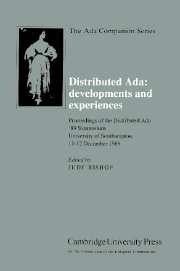 Distributed Ada: Developments and Experiences
Distributed Ada: Developments and Experiences Book contents
- Frontmatter
- Contents
- Preface
- Distributed Ada – the Issues
- Distributed Ada – a Case Study
- Parallel Ada for Symmetrical Multiprocessors
- The York Distributed Ada Project
- From DIADEM to DRAGOON
- Honeywell Distributed Ada – Approach
- Honeywell Distributed Ada – Implementation
- Ada for Tightly Coupled Systems
- A Pragmatic Approach to Distributed Ada for Transputers
- Distributed Ada on Shared Memory Multiprocessors
- The MUMS Multiprocessor Ada Project
- A Portable Common Executable Environment for Ada
- Supporting Reliable Distributed Systems in Ada 9X
Honeywell Distributed Ada – Implementation
Published online by Cambridge University Press: 13 October 2009
- Frontmatter
- Contents
- Preface
- Distributed Ada – the Issues
- Distributed Ada – a Case Study
- Parallel Ada for Symmetrical Multiprocessors
- The York Distributed Ada Project
- From DIADEM to DRAGOON
- Honeywell Distributed Ada – Approach
- Honeywell Distributed Ada – Implementation
- Ada for Tightly Coupled Systems
- A Pragmatic Approach to Distributed Ada for Transputers
- Distributed Ada on Shared Memory Multiprocessors
- The MUMS Multiprocessor Ada Project
- A Portable Common Executable Environment for Ada
- Supporting Reliable Distributed Systems in Ada 9X
Summary
INTRODUCTION
Overview
This paper will present a study of practical design decisions relevant to the retargeting of a traditional compilation system to a distributed target environment. The knowledge was gathered during the course of Honeywell's Distributed Ada project which involved the retargeting of a full commercial Ada compilation system to a distributed environment. The goal of the project was to create a compilation system which would allow a single unmodified Ada program to be fragmented and executed in a distributed environment.
The Distributed Ada Project
The trend in embedded system architectures is shifting from uniprocessor systems to networks of multiple computers. Advances in software tools and methodologies have not kept pace with advances in using distributed system architectures. In current practice, the tools designed for developing software on uniprocessor systems are used even when the target hardware is distributed. Typically, the application developer factors the hardware configuration into software design very early in the development process and writes a separate program for each processor in the system. In this way, software design gets burdened with hardware information that is unrelated to the application functionality. The paradigm is also weak in that no compiler sees the entire application. Because of this, the semantics of remote operations are likely to be different from local operations and the type checking that the compiler provides is defeated for inter-processor operations.
- Type
- Chapter
- Information
- Distributed Ada: Developments and ExperiencesProceedings of the Distributed Ada '89 Symposium, University of Southampton, 11–12 December 1989, pp. 158 - 176Publisher: Cambridge University PressPrint publication year: 1990
- 2
- Cited by
